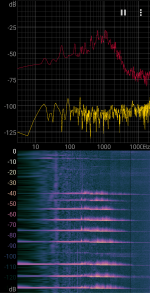Now CAD in a 1 mm slit from throat to mouth to break the circular bell modes of that shape? 🙂 to be filled with silicone etc... an increasing amplitude sinus shape?
//
//
Should that help? Is that only a theoretical assumption or did you actually measure these things on a waveguide?
Well, it's I would say a theoretical idea and I have done it practically - but no measurements ;-/
//
//
It looks funny, but so what? Admit that you have seen nothing like it 🙂
https://at-horns.eu/ext/MAXVAR-TEST-STL.zip


https://at-horns.eu/ext/MAXVAR-TEST-STL.zip
This is what also came to my mind but I have no idea about the performance. I won't model it in BEM but it should be possible to print and test.
(Only two rows of holes are indicated. The idea is to make the edge progressively "disappear".)

(Only two rows of holes are indicated. The idea is to make the edge progressively "disappear".)
No idea as I haven't tried it. I was just thinking that if dimensional accuracy is important it may not be the best choice.Is that necessarily a problem? Do you think it would detach from a mold?
I realized similar idea in my coaxses 🙂This is what also came to my mind but I have no idea about the performance. I won't model it in BEM but it should be possible to print and test.
(Only two rows of holes are indicated. The idea is to make the edge progressively "disappear".)
View attachment 1128631
Hi, yeah this is good view as it has the device in there to give insight. Downside is that it shows some particular frequency at a time, slider control to change frequency in real time would be great to get even more insight.The best way to "see" it, is to calculate observation fields. This version is a bit Hyper cardioid at 4K.
Regarding the hyper cardioid pattern, something similar happens to all devices for bandwidth there is edge diffraction, sound going around edge of the device be it box or sphere or waveguide like this. There is fun thought experiment for it: Imagine attaching two equal length strings to center of the driver, length being such that it takes you farfield when you pull them straight. Pull the strings with your hands around each side of the device, fully extended exactly behind the device and their ends meet. Path length is equal around both sides and constructive interference happens. Start moving to side and the string ends start to slide further from each other showing path length difference. Eventually there is some destructive interference if 1/2wl path length difference is reached. Basically nulls can form on off-axis to frequencies whose wavelength is shorter than roughly circumference of the device. The nulls turn to various angles depending on wavelength. Pattern due to this, sound around the device is either quite uniform omni like when wavelength is long and cardioidish when wavelength is short enough so that it is beamed mostly forward and very little goes toward (bafle) edge of device. Between these extremes is this hyper cardioidish thing going on, constructive interference at least exactly behind the device and some amount of nulls/lobes forming to sides between roughly 90-180 deg off-axis. Less so < 90 angles because very little sound goes all the way around.
Last edited:
Those look great. I assume that if you wanted to share some data you would do it already, so I won't ask for that.
I used the slots to reduce an effect of diffraction on both both off and on-axis frequency response. I don’t remember all the details now (I was designed the horn back in 2019), I need to revise the simulations, but I remember that width and the axial distance of the slits was of great importance for suppressing the diffraction effect in the desired frequency range.
These narrow slits/small holes are pain in the a.s.s when it comes to painting works. 🙂
Vacs kinda allows this, but there you see only one contour.Downside is that it shows some particular frequency at a time, slider control to change frequency in real time would be great to get even more insight.
Dmitrij_S - I'm really fascinated by the appearance, it's just marvelous. It's so unusual yet so easy on the eye. Bravo. I contemplated making something similar but would've never thought it can look so great in the end.
- So, where are the woofers? 🙂
- So, where are the woofers? 🙂
- Home
- Loudspeakers
- Multi-Way
- Acoustic Horn Design – The Easy Way (Ath4)
